Climate Change Report: Solar Energy Retailer Business Analysis
VerifiedAdded on 2020/05/03
|14
|3591
|64
Report
AI Summary
This report examines the multifaceted impacts of climate change on the solar energy retail sector. It begins with an executive summary and delves into the sector's overview, focusing on renewable energy sources, particularly solar power. The report analyzes the predicted climate impacts on solar energy retailers, including the effects of global warming, humidity, and air pollution on photovoltaic panel performance and energy production. It then provides a detailed comparison and contrast of the carbon tax and the direct action plan implemented by the Australian government, evaluating their effectiveness in reducing carbon emissions and their economic consequences. The report further assesses the risks and opportunities for solar energy retailers in a carbon-constrained world, emphasizing the low carbon intensity of solar energy. Finally, it outlines appropriate adaptation strategies for the sector, concluding with recommendations for increasing the availability of photovoltaic panels and promoting renewable energy sources. The report underscores the importance of renewable energy, especially solar, in mitigating the adverse effects of climate change.
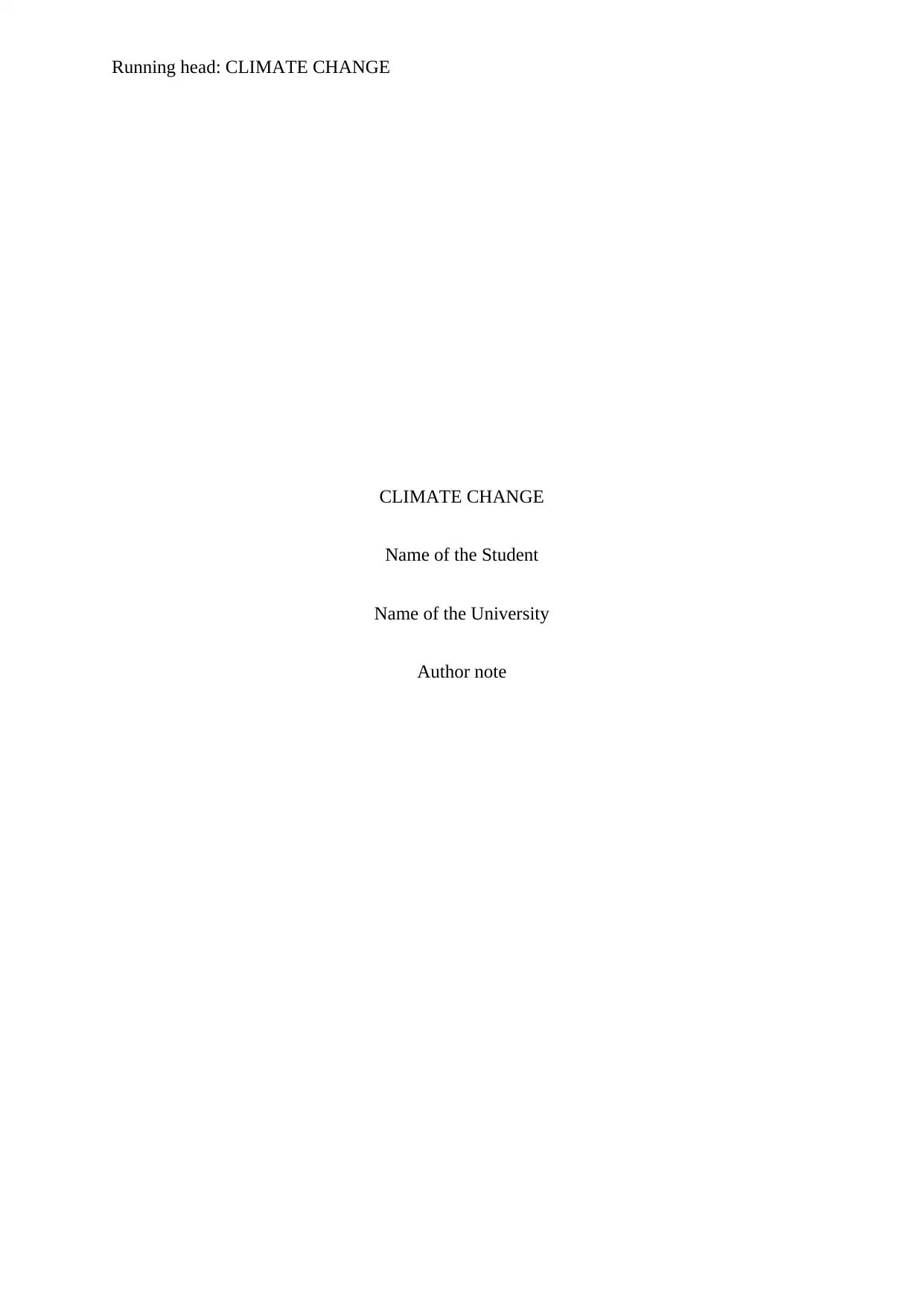
Running head: CLIMATE CHANGE
CLIMATE CHANGE
Name of the Student
Name of the University
Author note
CLIMATE CHANGE
Name of the Student
Name of the University
Author note
Paraphrase This Document
Need a fresh take? Get an instant paraphrase of this document with our AI Paraphraser
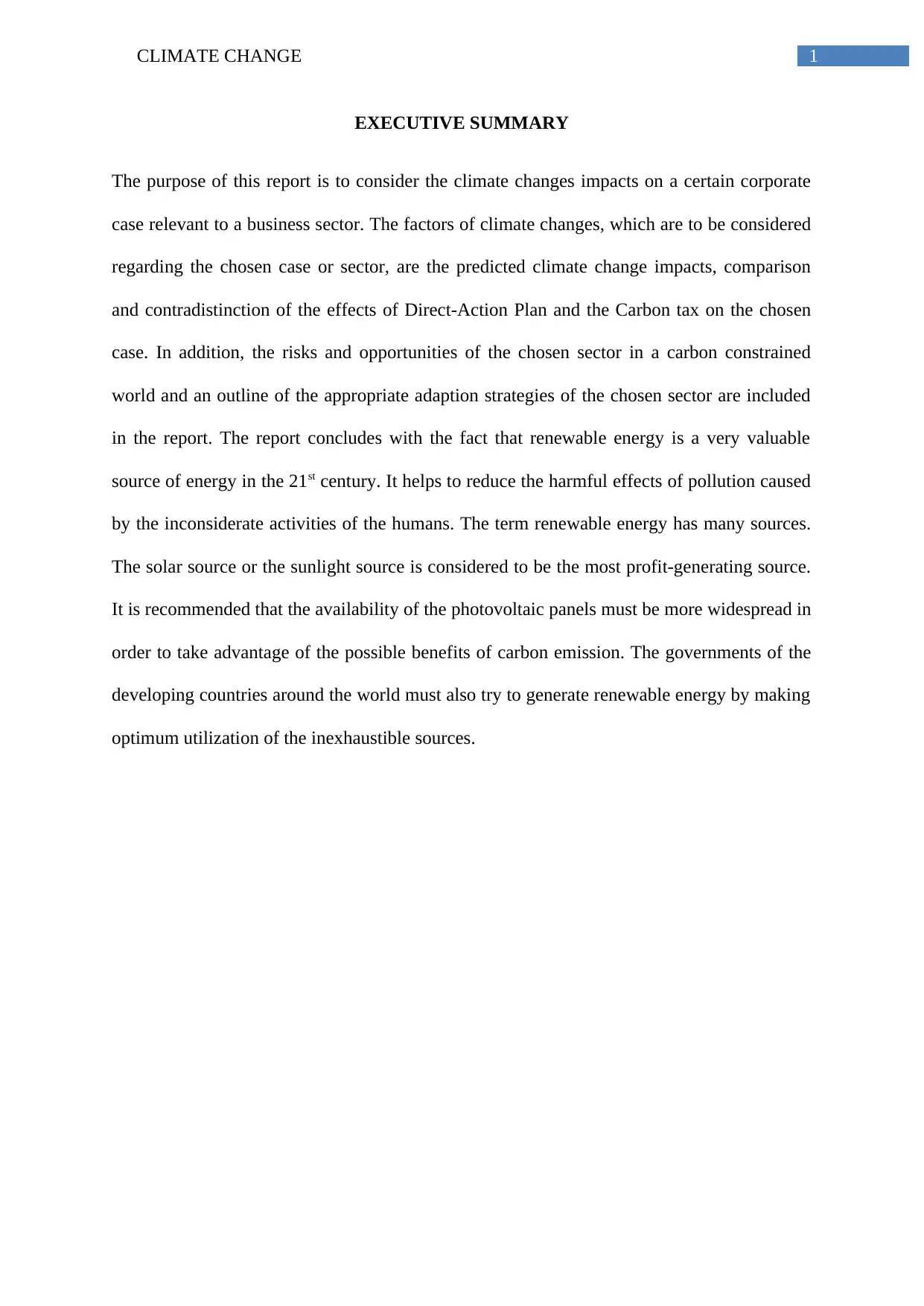
1CLIMATE CHANGE
EXECUTIVE SUMMARY
The purpose of this report is to consider the climate changes impacts on a certain corporate
case relevant to a business sector. The factors of climate changes, which are to be considered
regarding the chosen case or sector, are the predicted climate change impacts, comparison
and contradistinction of the effects of Direct-Action Plan and the Carbon tax on the chosen
case. In addition, the risks and opportunities of the chosen sector in a carbon constrained
world and an outline of the appropriate adaption strategies of the chosen sector are included
in the report. The report concludes with the fact that renewable energy is a very valuable
source of energy in the 21st century. It helps to reduce the harmful effects of pollution caused
by the inconsiderate activities of the humans. The term renewable energy has many sources.
The solar source or the sunlight source is considered to be the most profit-generating source.
It is recommended that the availability of the photovoltaic panels must be more widespread in
order to take advantage of the possible benefits of carbon emission. The governments of the
developing countries around the world must also try to generate renewable energy by making
optimum utilization of the inexhaustible sources.
EXECUTIVE SUMMARY
The purpose of this report is to consider the climate changes impacts on a certain corporate
case relevant to a business sector. The factors of climate changes, which are to be considered
regarding the chosen case or sector, are the predicted climate change impacts, comparison
and contradistinction of the effects of Direct-Action Plan and the Carbon tax on the chosen
case. In addition, the risks and opportunities of the chosen sector in a carbon constrained
world and an outline of the appropriate adaption strategies of the chosen sector are included
in the report. The report concludes with the fact that renewable energy is a very valuable
source of energy in the 21st century. It helps to reduce the harmful effects of pollution caused
by the inconsiderate activities of the humans. The term renewable energy has many sources.
The solar source or the sunlight source is considered to be the most profit-generating source.
It is recommended that the availability of the photovoltaic panels must be more widespread in
order to take advantage of the possible benefits of carbon emission. The governments of the
developing countries around the world must also try to generate renewable energy by making
optimum utilization of the inexhaustible sources.
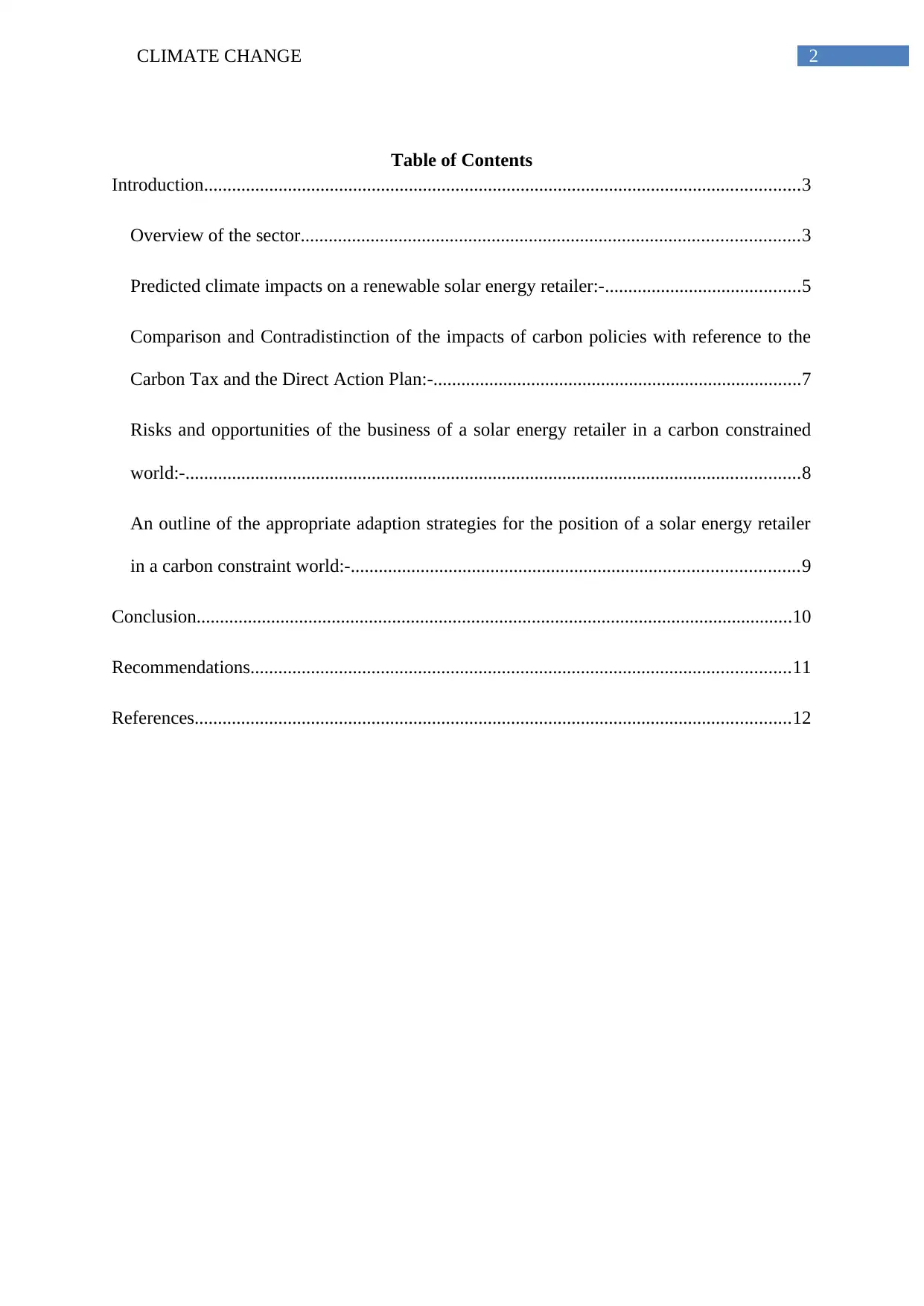
2CLIMATE CHANGE
Table of Contents
Introduction................................................................................................................................3
Overview of the sector...........................................................................................................3
Predicted climate impacts on a renewable solar energy retailer:-..........................................5
Comparison and Contradistinction of the impacts of carbon policies with reference to the
Carbon Tax and the Direct Action Plan:-...............................................................................7
Risks and opportunities of the business of a solar energy retailer in a carbon constrained
world:-....................................................................................................................................8
An outline of the appropriate adaption strategies for the position of a solar energy retailer
in a carbon constraint world:-................................................................................................9
Conclusion................................................................................................................................10
Recommendations....................................................................................................................11
References................................................................................................................................12
Table of Contents
Introduction................................................................................................................................3
Overview of the sector...........................................................................................................3
Predicted climate impacts on a renewable solar energy retailer:-..........................................5
Comparison and Contradistinction of the impacts of carbon policies with reference to the
Carbon Tax and the Direct Action Plan:-...............................................................................7
Risks and opportunities of the business of a solar energy retailer in a carbon constrained
world:-....................................................................................................................................8
An outline of the appropriate adaption strategies for the position of a solar energy retailer
in a carbon constraint world:-................................................................................................9
Conclusion................................................................................................................................10
Recommendations....................................................................................................................11
References................................................................................................................................12
⊘ This is a preview!⊘
Do you want full access?
Subscribe today to unlock all pages.

Trusted by 1+ million students worldwide
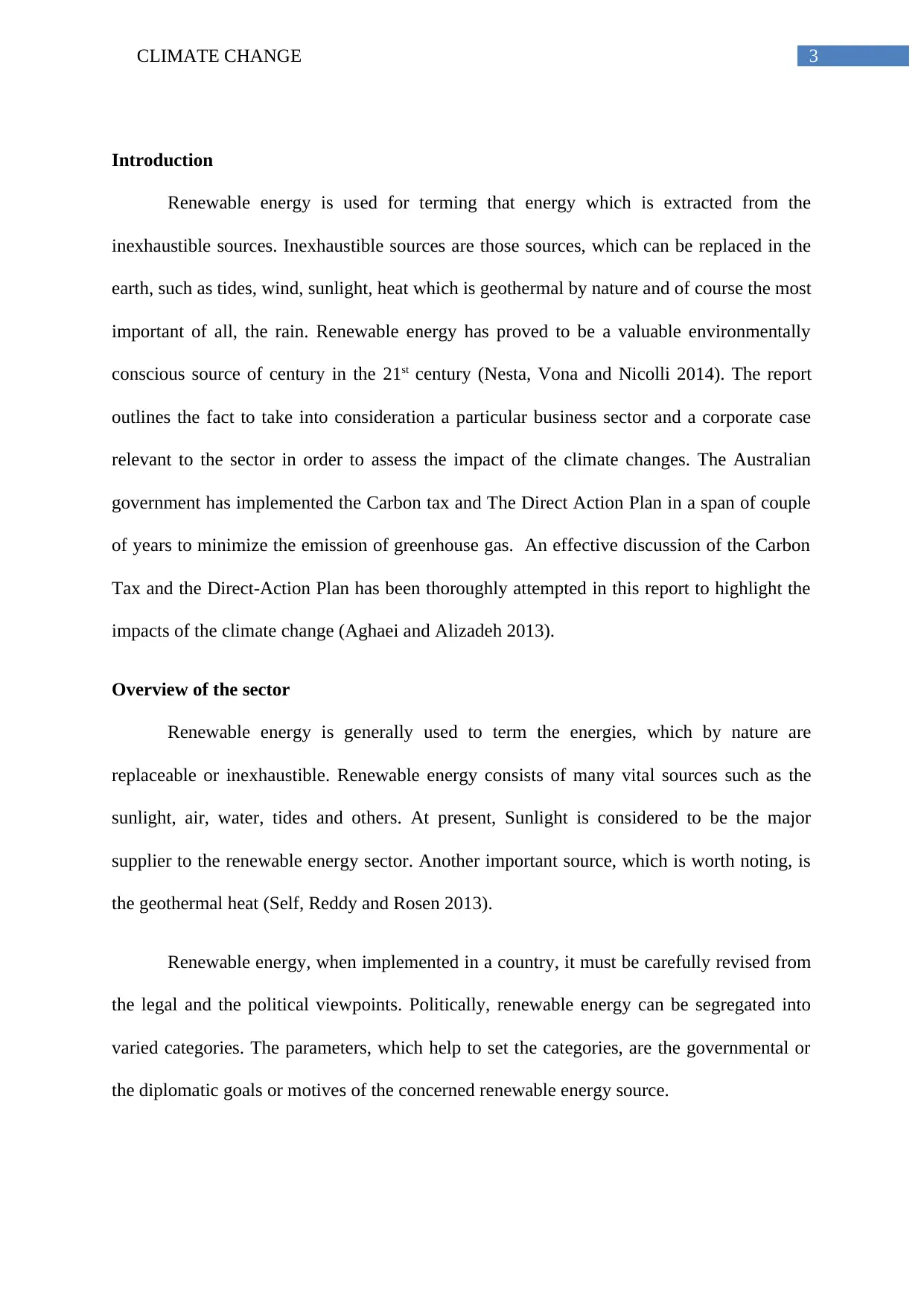
3CLIMATE CHANGE
Introduction
Renewable energy is used for terming that energy which is extracted from the
inexhaustible sources. Inexhaustible sources are those sources, which can be replaced in the
earth, such as tides, wind, sunlight, heat which is geothermal by nature and of course the most
important of all, the rain. Renewable energy has proved to be a valuable environmentally
conscious source of century in the 21st century (Nesta, Vona and Nicolli 2014). The report
outlines the fact to take into consideration a particular business sector and a corporate case
relevant to the sector in order to assess the impact of the climate changes. The Australian
government has implemented the Carbon tax and The Direct Action Plan in a span of couple
of years to minimize the emission of greenhouse gas. An effective discussion of the Carbon
Tax and the Direct-Action Plan has been thoroughly attempted in this report to highlight the
impacts of the climate change (Aghaei and Alizadeh 2013).
Overview of the sector
Renewable energy is generally used to term the energies, which by nature are
replaceable or inexhaustible. Renewable energy consists of many vital sources such as the
sunlight, air, water, tides and others. At present, Sunlight is considered to be the major
supplier to the renewable energy sector. Another important source, which is worth noting, is
the geothermal heat (Self, Reddy and Rosen 2013).
Renewable energy, when implemented in a country, it must be carefully revised from
the legal and the political viewpoints. Politically, renewable energy can be segregated into
varied categories. The parameters, which help to set the categories, are the governmental or
the diplomatic goals or motives of the concerned renewable energy source.
Introduction
Renewable energy is used for terming that energy which is extracted from the
inexhaustible sources. Inexhaustible sources are those sources, which can be replaced in the
earth, such as tides, wind, sunlight, heat which is geothermal by nature and of course the most
important of all, the rain. Renewable energy has proved to be a valuable environmentally
conscious source of century in the 21st century (Nesta, Vona and Nicolli 2014). The report
outlines the fact to take into consideration a particular business sector and a corporate case
relevant to the sector in order to assess the impact of the climate changes. The Australian
government has implemented the Carbon tax and The Direct Action Plan in a span of couple
of years to minimize the emission of greenhouse gas. An effective discussion of the Carbon
Tax and the Direct-Action Plan has been thoroughly attempted in this report to highlight the
impacts of the climate change (Aghaei and Alizadeh 2013).
Overview of the sector
Renewable energy is generally used to term the energies, which by nature are
replaceable or inexhaustible. Renewable energy consists of many vital sources such as the
sunlight, air, water, tides and others. At present, Sunlight is considered to be the major
supplier to the renewable energy sector. Another important source, which is worth noting, is
the geothermal heat (Self, Reddy and Rosen 2013).
Renewable energy, when implemented in a country, it must be carefully revised from
the legal and the political viewpoints. Politically, renewable energy can be segregated into
varied categories. The parameters, which help to set the categories, are the governmental or
the diplomatic goals or motives of the concerned renewable energy source.
Paraphrase This Document
Need a fresh take? Get an instant paraphrase of this document with our AI Paraphraser
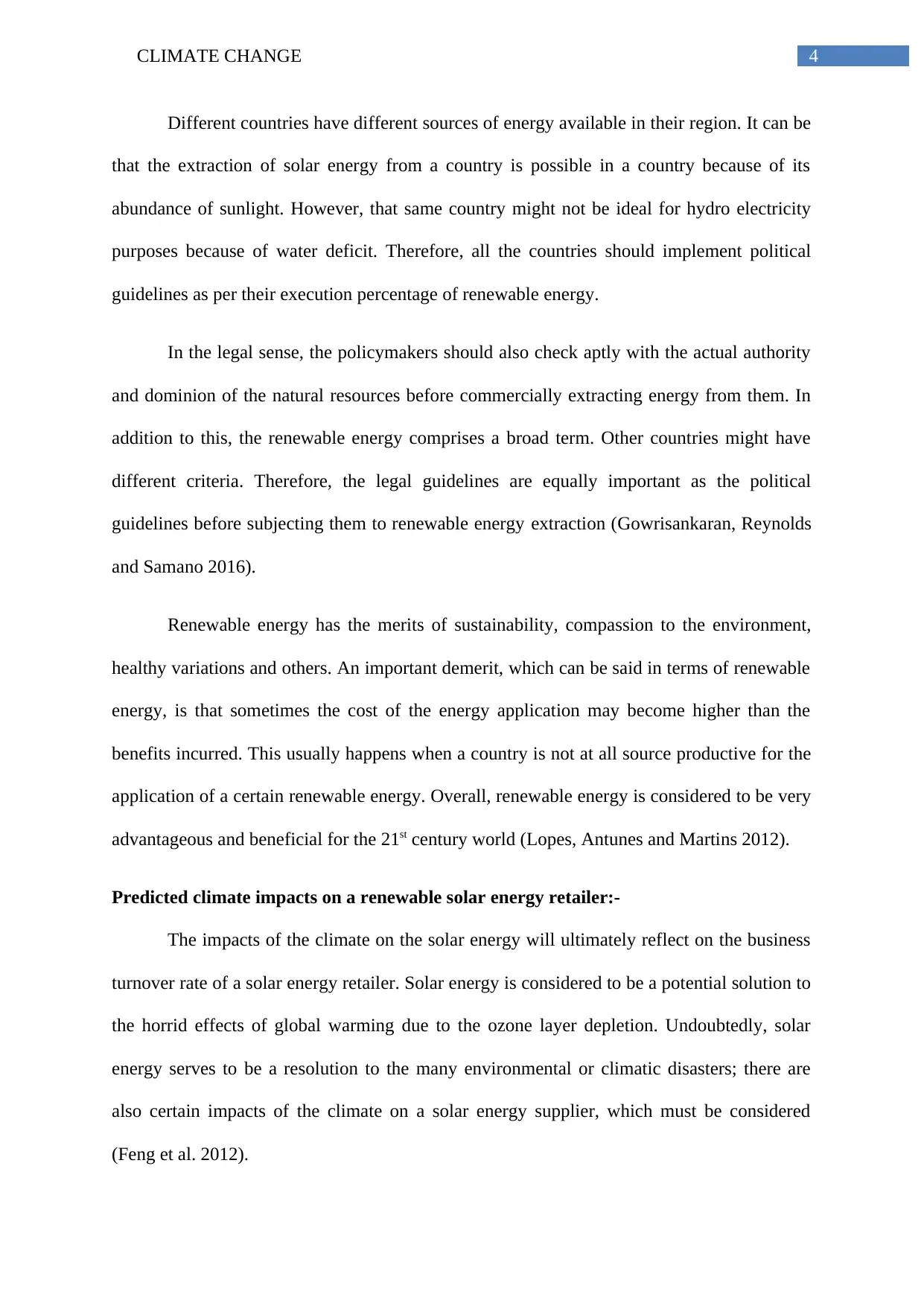
4CLIMATE CHANGE
Different countries have different sources of energy available in their region. It can be
that the extraction of solar energy from a country is possible in a country because of its
abundance of sunlight. However, that same country might not be ideal for hydro electricity
purposes because of water deficit. Therefore, all the countries should implement political
guidelines as per their execution percentage of renewable energy.
In the legal sense, the policymakers should also check aptly with the actual authority
and dominion of the natural resources before commercially extracting energy from them. In
addition to this, the renewable energy comprises a broad term. Other countries might have
different criteria. Therefore, the legal guidelines are equally important as the political
guidelines before subjecting them to renewable energy extraction (Gowrisankaran, Reynolds
and Samano 2016).
Renewable energy has the merits of sustainability, compassion to the environment,
healthy variations and others. An important demerit, which can be said in terms of renewable
energy, is that sometimes the cost of the energy application may become higher than the
benefits incurred. This usually happens when a country is not at all source productive for the
application of a certain renewable energy. Overall, renewable energy is considered to be very
advantageous and beneficial for the 21st century world (Lopes, Antunes and Martins 2012).
Predicted climate impacts on a renewable solar energy retailer:-
The impacts of the climate on the solar energy will ultimately reflect on the business
turnover rate of a solar energy retailer. Solar energy is considered to be a potential solution to
the horrid effects of global warming due to the ozone layer depletion. Undoubtedly, solar
energy serves to be a resolution to the many environmental or climatic disasters; there are
also certain impacts of the climate on a solar energy supplier, which must be considered
(Feng et al. 2012).
Different countries have different sources of energy available in their region. It can be
that the extraction of solar energy from a country is possible in a country because of its
abundance of sunlight. However, that same country might not be ideal for hydro electricity
purposes because of water deficit. Therefore, all the countries should implement political
guidelines as per their execution percentage of renewable energy.
In the legal sense, the policymakers should also check aptly with the actual authority
and dominion of the natural resources before commercially extracting energy from them. In
addition to this, the renewable energy comprises a broad term. Other countries might have
different criteria. Therefore, the legal guidelines are equally important as the political
guidelines before subjecting them to renewable energy extraction (Gowrisankaran, Reynolds
and Samano 2016).
Renewable energy has the merits of sustainability, compassion to the environment,
healthy variations and others. An important demerit, which can be said in terms of renewable
energy, is that sometimes the cost of the energy application may become higher than the
benefits incurred. This usually happens when a country is not at all source productive for the
application of a certain renewable energy. Overall, renewable energy is considered to be very
advantageous and beneficial for the 21st century world (Lopes, Antunes and Martins 2012).
Predicted climate impacts on a renewable solar energy retailer:-
The impacts of the climate on the solar energy will ultimately reflect on the business
turnover rate of a solar energy retailer. Solar energy is considered to be a potential solution to
the horrid effects of global warming due to the ozone layer depletion. Undoubtedly, solar
energy serves to be a resolution to the many environmental or climatic disasters; there are
also certain impacts of the climate on a solar energy supplier, which must be considered
(Feng et al. 2012).
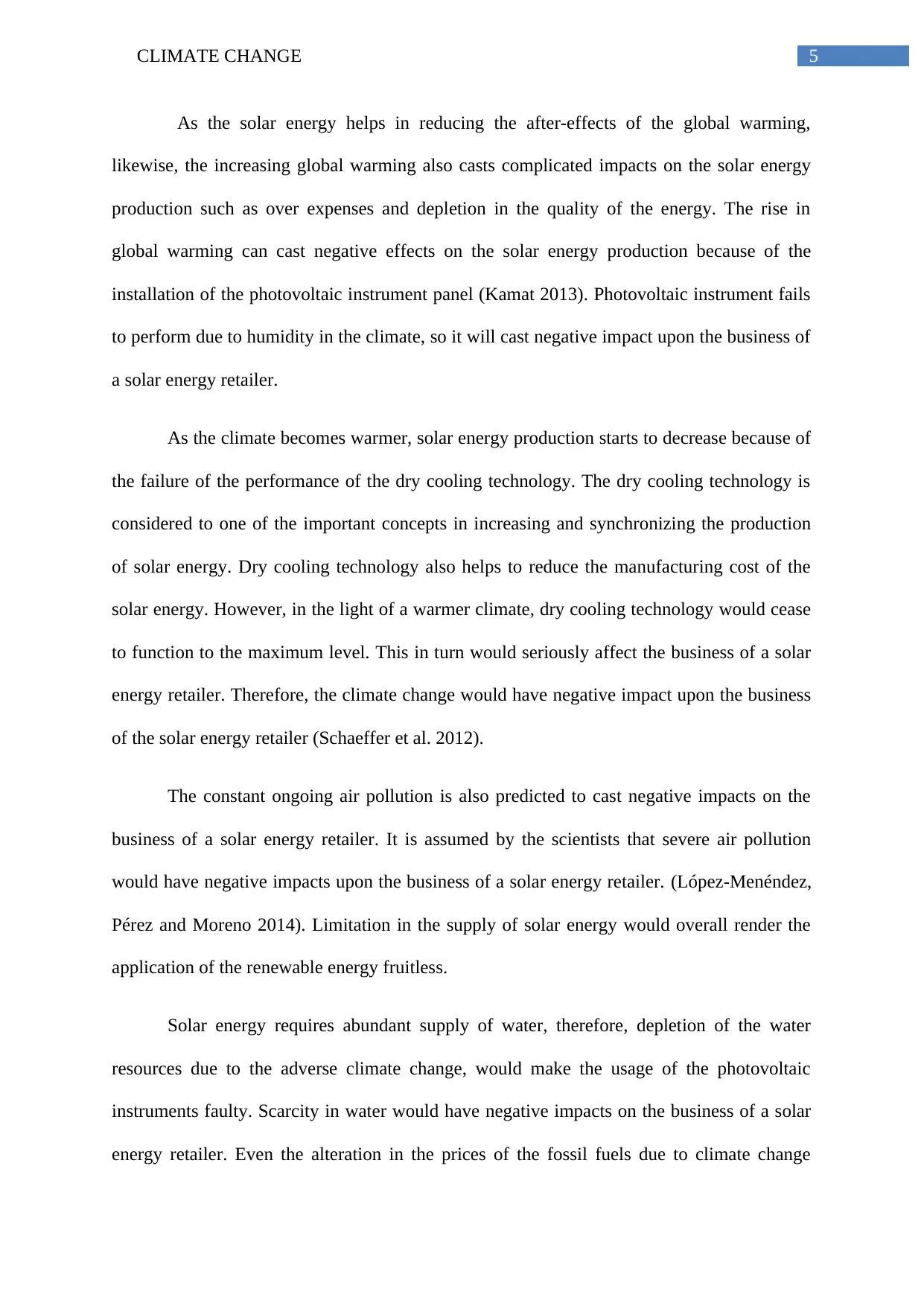
5CLIMATE CHANGE
As the solar energy helps in reducing the after-effects of the global warming,
likewise, the increasing global warming also casts complicated impacts on the solar energy
production such as over expenses and depletion in the quality of the energy. The rise in
global warming can cast negative effects on the solar energy production because of the
installation of the photovoltaic instrument panel (Kamat 2013). Photovoltaic instrument fails
to perform due to humidity in the climate, so it will cast negative impact upon the business of
a solar energy retailer.
As the climate becomes warmer, solar energy production starts to decrease because of
the failure of the performance of the dry cooling technology. The dry cooling technology is
considered to one of the important concepts in increasing and synchronizing the production
of solar energy. Dry cooling technology also helps to reduce the manufacturing cost of the
solar energy. However, in the light of a warmer climate, dry cooling technology would cease
to function to the maximum level. This in turn would seriously affect the business of a solar
energy retailer. Therefore, the climate change would have negative impact upon the business
of the solar energy retailer (Schaeffer et al. 2012).
The constant ongoing air pollution is also predicted to cast negative impacts on the
business of a solar energy retailer. It is assumed by the scientists that severe air pollution
would have negative impacts upon the business of a solar energy retailer. (López-Menéndez,
Pérez and Moreno 2014). Limitation in the supply of solar energy would overall render the
application of the renewable energy fruitless.
Solar energy requires abundant supply of water, therefore, depletion of the water
resources due to the adverse climate change, would make the usage of the photovoltaic
instruments faulty. Scarcity in water would have negative impacts on the business of a solar
energy retailer. Even the alteration in the prices of the fossil fuels due to climate change
As the solar energy helps in reducing the after-effects of the global warming,
likewise, the increasing global warming also casts complicated impacts on the solar energy
production such as over expenses and depletion in the quality of the energy. The rise in
global warming can cast negative effects on the solar energy production because of the
installation of the photovoltaic instrument panel (Kamat 2013). Photovoltaic instrument fails
to perform due to humidity in the climate, so it will cast negative impact upon the business of
a solar energy retailer.
As the climate becomes warmer, solar energy production starts to decrease because of
the failure of the performance of the dry cooling technology. The dry cooling technology is
considered to one of the important concepts in increasing and synchronizing the production
of solar energy. Dry cooling technology also helps to reduce the manufacturing cost of the
solar energy. However, in the light of a warmer climate, dry cooling technology would cease
to function to the maximum level. This in turn would seriously affect the business of a solar
energy retailer. Therefore, the climate change would have negative impact upon the business
of the solar energy retailer (Schaeffer et al. 2012).
The constant ongoing air pollution is also predicted to cast negative impacts on the
business of a solar energy retailer. It is assumed by the scientists that severe air pollution
would have negative impacts upon the business of a solar energy retailer. (López-Menéndez,
Pérez and Moreno 2014). Limitation in the supply of solar energy would overall render the
application of the renewable energy fruitless.
Solar energy requires abundant supply of water, therefore, depletion of the water
resources due to the adverse climate change, would make the usage of the photovoltaic
instruments faulty. Scarcity in water would have negative impacts on the business of a solar
energy retailer. Even the alteration in the prices of the fossil fuels due to climate change
⊘ This is a preview!⊘
Do you want full access?
Subscribe today to unlock all pages.

Trusted by 1+ million students worldwide
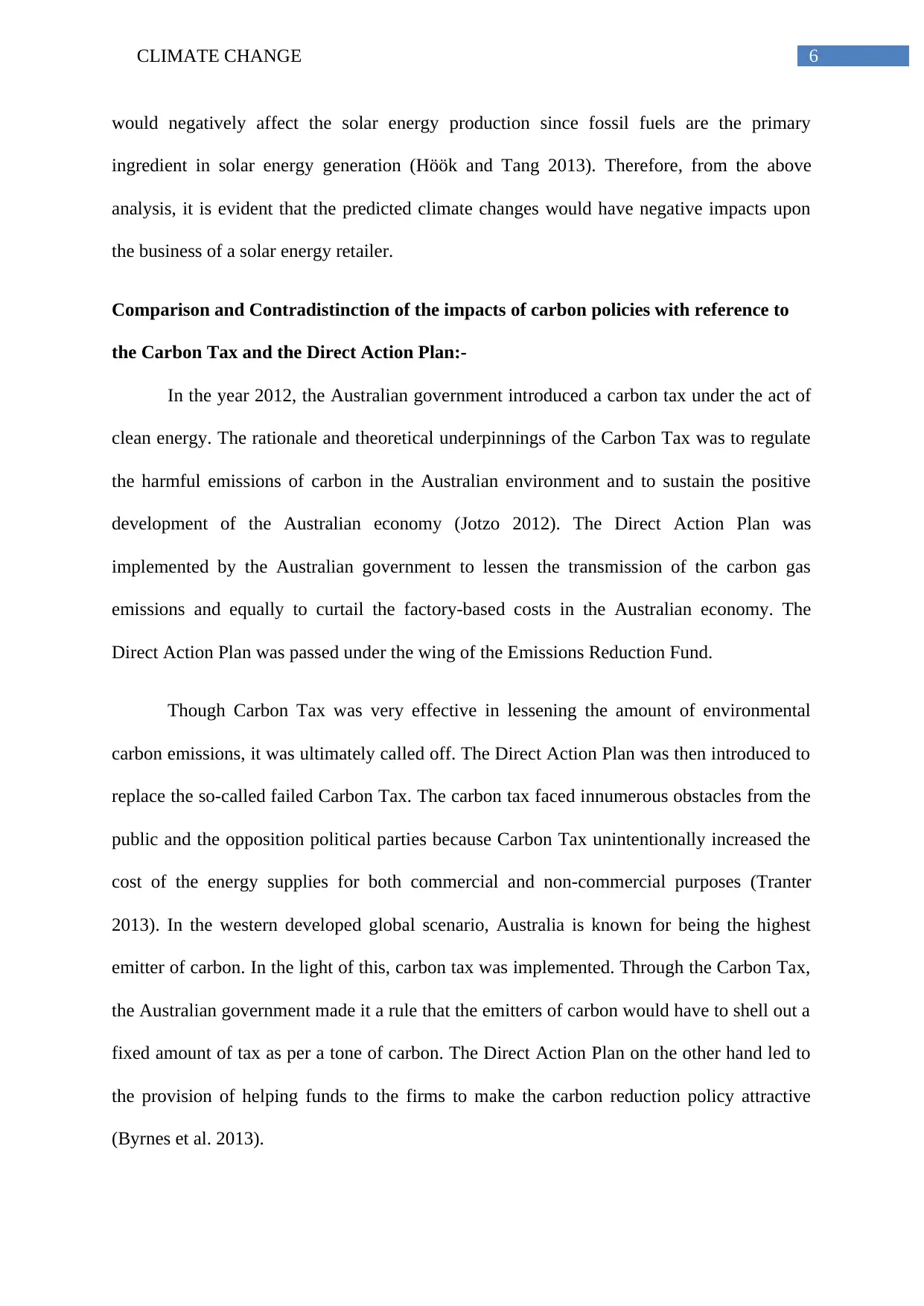
6CLIMATE CHANGE
would negatively affect the solar energy production since fossil fuels are the primary
ingredient in solar energy generation (Höök and Tang 2013). Therefore, from the above
analysis, it is evident that the predicted climate changes would have negative impacts upon
the business of a solar energy retailer.
Comparison and Contradistinction of the impacts of carbon policies with reference to
the Carbon Tax and the Direct Action Plan:-
In the year 2012, the Australian government introduced a carbon tax under the act of
clean energy. The rationale and theoretical underpinnings of the Carbon Tax was to regulate
the harmful emissions of carbon in the Australian environment and to sustain the positive
development of the Australian economy (Jotzo 2012). The Direct Action Plan was
implemented by the Australian government to lessen the transmission of the carbon gas
emissions and equally to curtail the factory-based costs in the Australian economy. The
Direct Action Plan was passed under the wing of the Emissions Reduction Fund.
Though Carbon Tax was very effective in lessening the amount of environmental
carbon emissions, it was ultimately called off. The Direct Action Plan was then introduced to
replace the so-called failed Carbon Tax. The carbon tax faced innumerous obstacles from the
public and the opposition political parties because Carbon Tax unintentionally increased the
cost of the energy supplies for both commercial and non-commercial purposes (Tranter
2013). In the western developed global scenario, Australia is known for being the highest
emitter of carbon. In the light of this, carbon tax was implemented. Through the Carbon Tax,
the Australian government made it a rule that the emitters of carbon would have to shell out a
fixed amount of tax as per a tone of carbon. The Direct Action Plan on the other hand led to
the provision of helping funds to the firms to make the carbon reduction policy attractive
(Byrnes et al. 2013).
would negatively affect the solar energy production since fossil fuels are the primary
ingredient in solar energy generation (Höök and Tang 2013). Therefore, from the above
analysis, it is evident that the predicted climate changes would have negative impacts upon
the business of a solar energy retailer.
Comparison and Contradistinction of the impacts of carbon policies with reference to
the Carbon Tax and the Direct Action Plan:-
In the year 2012, the Australian government introduced a carbon tax under the act of
clean energy. The rationale and theoretical underpinnings of the Carbon Tax was to regulate
the harmful emissions of carbon in the Australian environment and to sustain the positive
development of the Australian economy (Jotzo 2012). The Direct Action Plan was
implemented by the Australian government to lessen the transmission of the carbon gas
emissions and equally to curtail the factory-based costs in the Australian economy. The
Direct Action Plan was passed under the wing of the Emissions Reduction Fund.
Though Carbon Tax was very effective in lessening the amount of environmental
carbon emissions, it was ultimately called off. The Direct Action Plan was then introduced to
replace the so-called failed Carbon Tax. The carbon tax faced innumerous obstacles from the
public and the opposition political parties because Carbon Tax unintentionally increased the
cost of the energy supplies for both commercial and non-commercial purposes (Tranter
2013). In the western developed global scenario, Australia is known for being the highest
emitter of carbon. In the light of this, carbon tax was implemented. Through the Carbon Tax,
the Australian government made it a rule that the emitters of carbon would have to shell out a
fixed amount of tax as per a tone of carbon. The Direct Action Plan on the other hand led to
the provision of helping funds to the firms to make the carbon reduction policy attractive
(Byrnes et al. 2013).
Paraphrase This Document
Need a fresh take? Get an instant paraphrase of this document with our AI Paraphraser
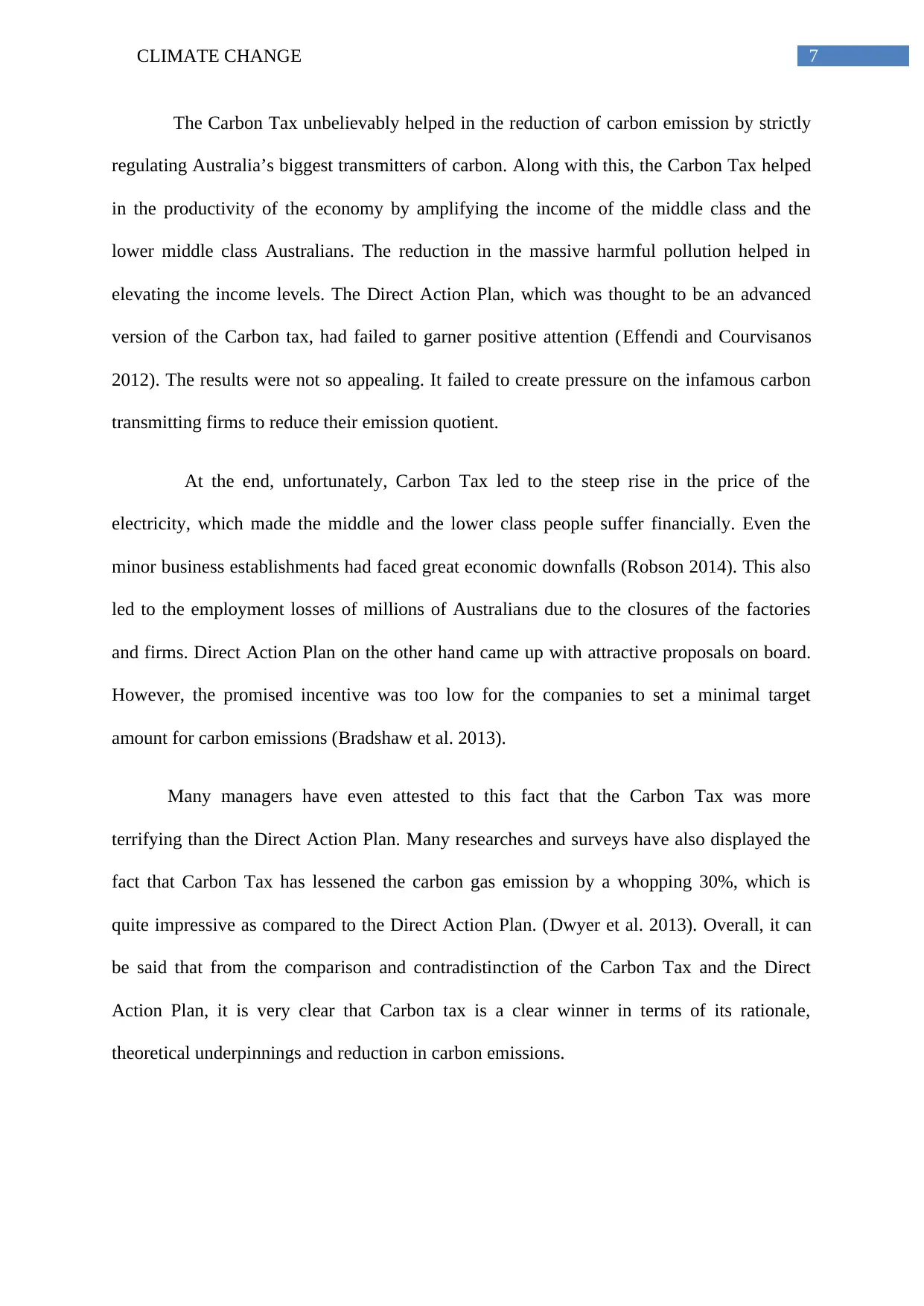
7CLIMATE CHANGE
The Carbon Tax unbelievably helped in the reduction of carbon emission by strictly
regulating Australia’s biggest transmitters of carbon. Along with this, the Carbon Tax helped
in the productivity of the economy by amplifying the income of the middle class and the
lower middle class Australians. The reduction in the massive harmful pollution helped in
elevating the income levels. The Direct Action Plan, which was thought to be an advanced
version of the Carbon tax, had failed to garner positive attention (Effendi and Courvisanos
2012). The results were not so appealing. It failed to create pressure on the infamous carbon
transmitting firms to reduce their emission quotient.
At the end, unfortunately, Carbon Tax led to the steep rise in the price of the
electricity, which made the middle and the lower class people suffer financially. Even the
minor business establishments had faced great economic downfalls (Robson 2014). This also
led to the employment losses of millions of Australians due to the closures of the factories
and firms. Direct Action Plan on the other hand came up with attractive proposals on board.
However, the promised incentive was too low for the companies to set a minimal target
amount for carbon emissions (Bradshaw et al. 2013).
Many managers have even attested to this fact that the Carbon Tax was more
terrifying than the Direct Action Plan. Many researches and surveys have also displayed the
fact that Carbon Tax has lessened the carbon gas emission by a whopping 30%, which is
quite impressive as compared to the Direct Action Plan. (Dwyer et al. 2013). Overall, it can
be said that from the comparison and contradistinction of the Carbon Tax and the Direct
Action Plan, it is very clear that Carbon tax is a clear winner in terms of its rationale,
theoretical underpinnings and reduction in carbon emissions.
The Carbon Tax unbelievably helped in the reduction of carbon emission by strictly
regulating Australia’s biggest transmitters of carbon. Along with this, the Carbon Tax helped
in the productivity of the economy by amplifying the income of the middle class and the
lower middle class Australians. The reduction in the massive harmful pollution helped in
elevating the income levels. The Direct Action Plan, which was thought to be an advanced
version of the Carbon tax, had failed to garner positive attention (Effendi and Courvisanos
2012). The results were not so appealing. It failed to create pressure on the infamous carbon
transmitting firms to reduce their emission quotient.
At the end, unfortunately, Carbon Tax led to the steep rise in the price of the
electricity, which made the middle and the lower class people suffer financially. Even the
minor business establishments had faced great economic downfalls (Robson 2014). This also
led to the employment losses of millions of Australians due to the closures of the factories
and firms. Direct Action Plan on the other hand came up with attractive proposals on board.
However, the promised incentive was too low for the companies to set a minimal target
amount for carbon emissions (Bradshaw et al. 2013).
Many managers have even attested to this fact that the Carbon Tax was more
terrifying than the Direct Action Plan. Many researches and surveys have also displayed the
fact that Carbon Tax has lessened the carbon gas emission by a whopping 30%, which is
quite impressive as compared to the Direct Action Plan. (Dwyer et al. 2013). Overall, it can
be said that from the comparison and contradistinction of the Carbon Tax and the Direct
Action Plan, it is very clear that Carbon tax is a clear winner in terms of its rationale,
theoretical underpinnings and reduction in carbon emissions.
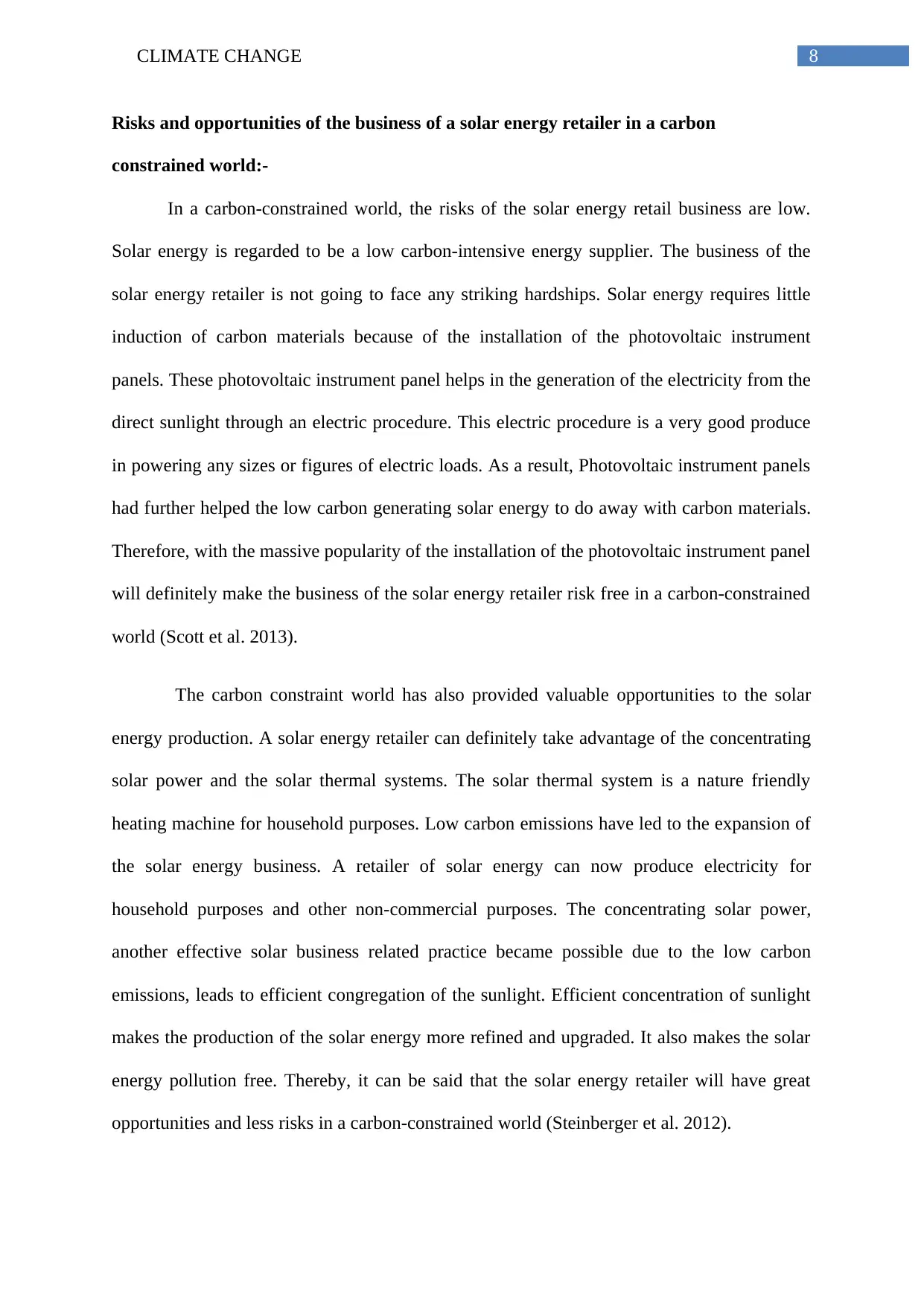
8CLIMATE CHANGE
Risks and opportunities of the business of a solar energy retailer in a carbon
constrained world:-
In a carbon-constrained world, the risks of the solar energy retail business are low.
Solar energy is regarded to be a low carbon-intensive energy supplier. The business of the
solar energy retailer is not going to face any striking hardships. Solar energy requires little
induction of carbon materials because of the installation of the photovoltaic instrument
panels. These photovoltaic instrument panel helps in the generation of the electricity from the
direct sunlight through an electric procedure. This electric procedure is a very good produce
in powering any sizes or figures of electric loads. As a result, Photovoltaic instrument panels
had further helped the low carbon generating solar energy to do away with carbon materials.
Therefore, with the massive popularity of the installation of the photovoltaic instrument panel
will definitely make the business of the solar energy retailer risk free in a carbon-constrained
world (Scott et al. 2013).
The carbon constraint world has also provided valuable opportunities to the solar
energy production. A solar energy retailer can definitely take advantage of the concentrating
solar power and the solar thermal systems. The solar thermal system is a nature friendly
heating machine for household purposes. Low carbon emissions have led to the expansion of
the solar energy business. A retailer of solar energy can now produce electricity for
household purposes and other non-commercial purposes. The concentrating solar power,
another effective solar business related practice became possible due to the low carbon
emissions, leads to efficient congregation of the sunlight. Efficient concentration of sunlight
makes the production of the solar energy more refined and upgraded. It also makes the solar
energy pollution free. Thereby, it can be said that the solar energy retailer will have great
opportunities and less risks in a carbon-constrained world (Steinberger et al. 2012).
Risks and opportunities of the business of a solar energy retailer in a carbon
constrained world:-
In a carbon-constrained world, the risks of the solar energy retail business are low.
Solar energy is regarded to be a low carbon-intensive energy supplier. The business of the
solar energy retailer is not going to face any striking hardships. Solar energy requires little
induction of carbon materials because of the installation of the photovoltaic instrument
panels. These photovoltaic instrument panel helps in the generation of the electricity from the
direct sunlight through an electric procedure. This electric procedure is a very good produce
in powering any sizes or figures of electric loads. As a result, Photovoltaic instrument panels
had further helped the low carbon generating solar energy to do away with carbon materials.
Therefore, with the massive popularity of the installation of the photovoltaic instrument panel
will definitely make the business of the solar energy retailer risk free in a carbon-constrained
world (Scott et al. 2013).
The carbon constraint world has also provided valuable opportunities to the solar
energy production. A solar energy retailer can definitely take advantage of the concentrating
solar power and the solar thermal systems. The solar thermal system is a nature friendly
heating machine for household purposes. Low carbon emissions have led to the expansion of
the solar energy business. A retailer of solar energy can now produce electricity for
household purposes and other non-commercial purposes. The concentrating solar power,
another effective solar business related practice became possible due to the low carbon
emissions, leads to efficient congregation of the sunlight. Efficient concentration of sunlight
makes the production of the solar energy more refined and upgraded. It also makes the solar
energy pollution free. Thereby, it can be said that the solar energy retailer will have great
opportunities and less risks in a carbon-constrained world (Steinberger et al. 2012).
⊘ This is a preview!⊘
Do you want full access?
Subscribe today to unlock all pages.

Trusted by 1+ million students worldwide
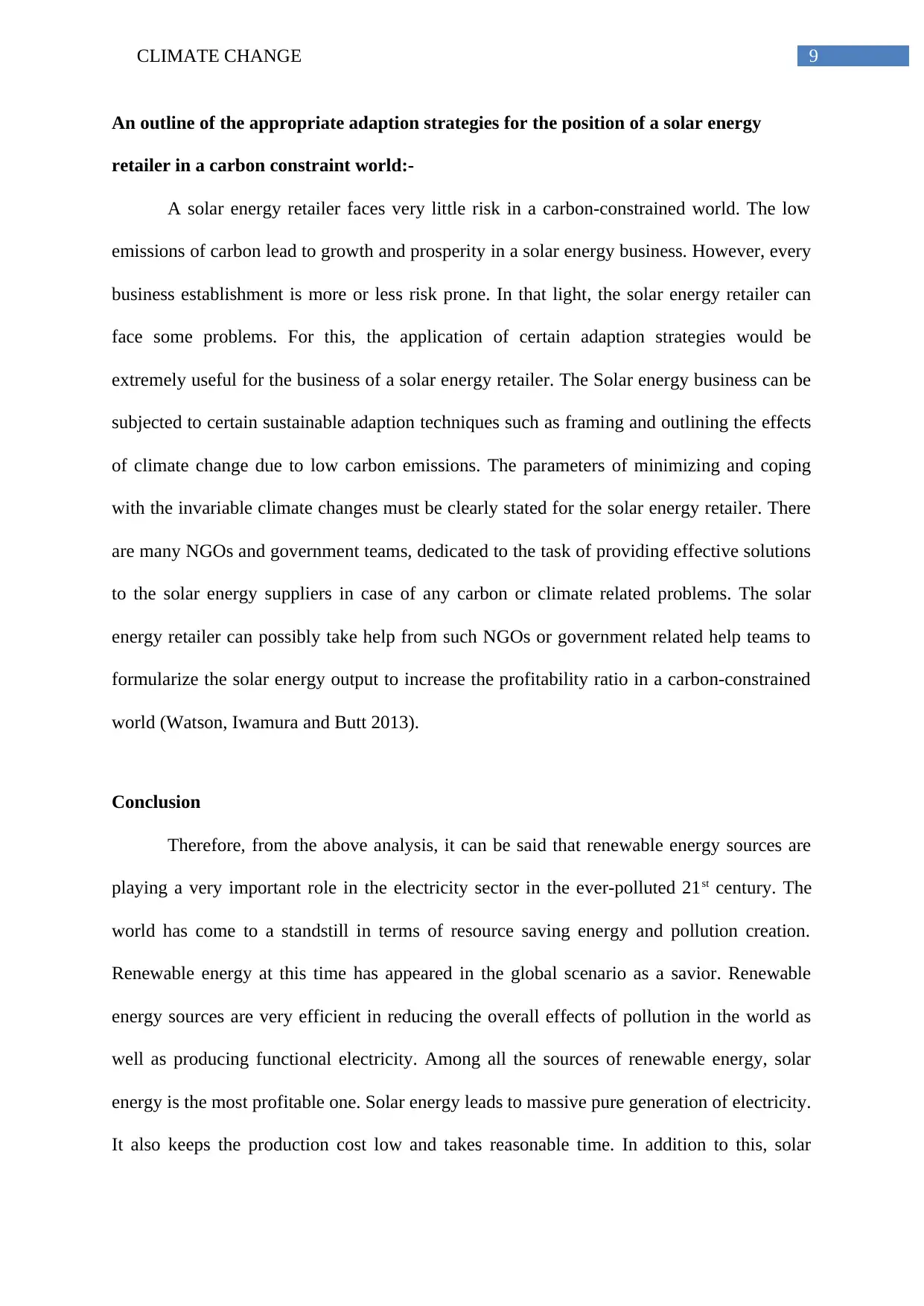
9CLIMATE CHANGE
An outline of the appropriate adaption strategies for the position of a solar energy
retailer in a carbon constraint world:-
A solar energy retailer faces very little risk in a carbon-constrained world. The low
emissions of carbon lead to growth and prosperity in a solar energy business. However, every
business establishment is more or less risk prone. In that light, the solar energy retailer can
face some problems. For this, the application of certain adaption strategies would be
extremely useful for the business of a solar energy retailer. The Solar energy business can be
subjected to certain sustainable adaption techniques such as framing and outlining the effects
of climate change due to low carbon emissions. The parameters of minimizing and coping
with the invariable climate changes must be clearly stated for the solar energy retailer. There
are many NGOs and government teams, dedicated to the task of providing effective solutions
to the solar energy suppliers in case of any carbon or climate related problems. The solar
energy retailer can possibly take help from such NGOs or government related help teams to
formularize the solar energy output to increase the profitability ratio in a carbon-constrained
world (Watson, Iwamura and Butt 2013).
Conclusion
Therefore, from the above analysis, it can be said that renewable energy sources are
playing a very important role in the electricity sector in the ever-polluted 21st century. The
world has come to a standstill in terms of resource saving energy and pollution creation.
Renewable energy at this time has appeared in the global scenario as a savior. Renewable
energy sources are very efficient in reducing the overall effects of pollution in the world as
well as producing functional electricity. Among all the sources of renewable energy, solar
energy is the most profitable one. Solar energy leads to massive pure generation of electricity.
It also keeps the production cost low and takes reasonable time. In addition to this, solar
An outline of the appropriate adaption strategies for the position of a solar energy
retailer in a carbon constraint world:-
A solar energy retailer faces very little risk in a carbon-constrained world. The low
emissions of carbon lead to growth and prosperity in a solar energy business. However, every
business establishment is more or less risk prone. In that light, the solar energy retailer can
face some problems. For this, the application of certain adaption strategies would be
extremely useful for the business of a solar energy retailer. The Solar energy business can be
subjected to certain sustainable adaption techniques such as framing and outlining the effects
of climate change due to low carbon emissions. The parameters of minimizing and coping
with the invariable climate changes must be clearly stated for the solar energy retailer. There
are many NGOs and government teams, dedicated to the task of providing effective solutions
to the solar energy suppliers in case of any carbon or climate related problems. The solar
energy retailer can possibly take help from such NGOs or government related help teams to
formularize the solar energy output to increase the profitability ratio in a carbon-constrained
world (Watson, Iwamura and Butt 2013).
Conclusion
Therefore, from the above analysis, it can be said that renewable energy sources are
playing a very important role in the electricity sector in the ever-polluted 21st century. The
world has come to a standstill in terms of resource saving energy and pollution creation.
Renewable energy at this time has appeared in the global scenario as a savior. Renewable
energy sources are very efficient in reducing the overall effects of pollution in the world as
well as producing functional electricity. Among all the sources of renewable energy, solar
energy is the most profitable one. Solar energy leads to massive pure generation of electricity.
It also keeps the production cost low and takes reasonable time. In addition to this, solar
Paraphrase This Document
Need a fresh take? Get an instant paraphrase of this document with our AI Paraphraser
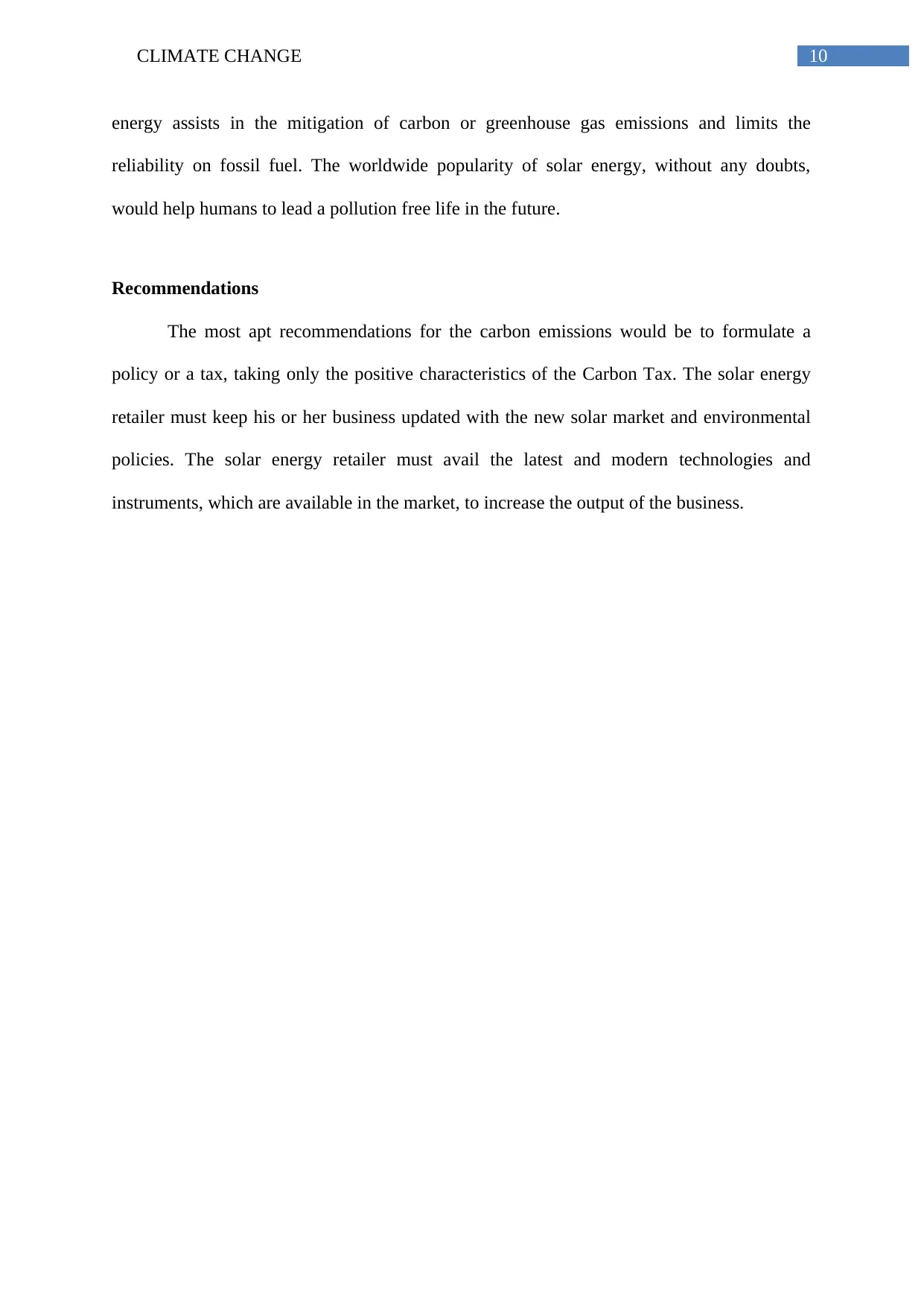
10CLIMATE CHANGE
energy assists in the mitigation of carbon or greenhouse gas emissions and limits the
reliability on fossil fuel. The worldwide popularity of solar energy, without any doubts,
would help humans to lead a pollution free life in the future.
Recommendations
The most apt recommendations for the carbon emissions would be to formulate a
policy or a tax, taking only the positive characteristics of the Carbon Tax. The solar energy
retailer must keep his or her business updated with the new solar market and environmental
policies. The solar energy retailer must avail the latest and modern technologies and
instruments, which are available in the market, to increase the output of the business.
energy assists in the mitigation of carbon or greenhouse gas emissions and limits the
reliability on fossil fuel. The worldwide popularity of solar energy, without any doubts,
would help humans to lead a pollution free life in the future.
Recommendations
The most apt recommendations for the carbon emissions would be to formulate a
policy or a tax, taking only the positive characteristics of the Carbon Tax. The solar energy
retailer must keep his or her business updated with the new solar market and environmental
policies. The solar energy retailer must avail the latest and modern technologies and
instruments, which are available in the market, to increase the output of the business.
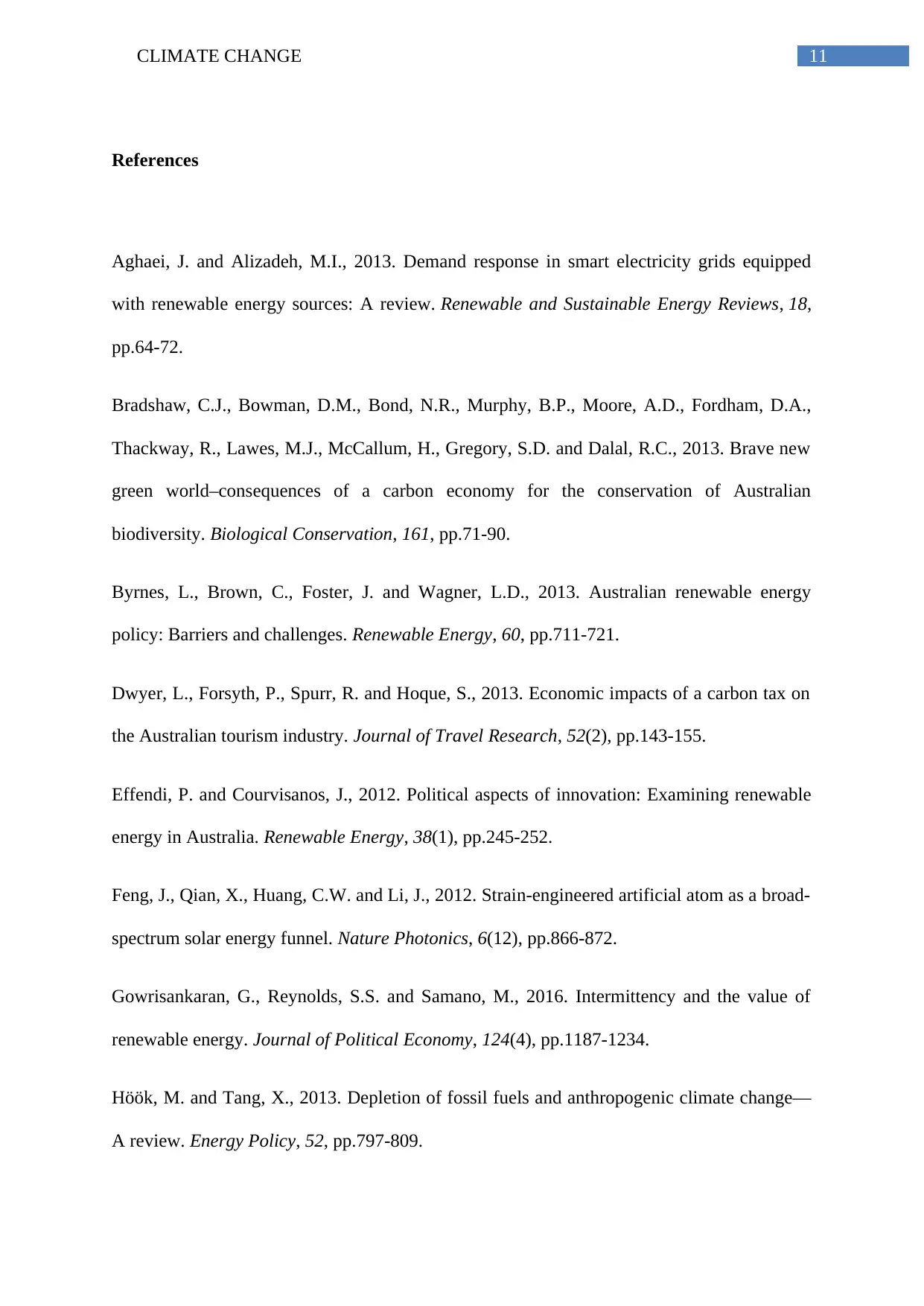
11CLIMATE CHANGE
References
Aghaei, J. and Alizadeh, M.I., 2013. Demand response in smart electricity grids equipped
with renewable energy sources: A review. Renewable and Sustainable Energy Reviews, 18,
pp.64-72.
Bradshaw, C.J., Bowman, D.M., Bond, N.R., Murphy, B.P., Moore, A.D., Fordham, D.A.,
Thackway, R., Lawes, M.J., McCallum, H., Gregory, S.D. and Dalal, R.C., 2013. Brave new
green world–consequences of a carbon economy for the conservation of Australian
biodiversity. Biological Conservation, 161, pp.71-90.
Byrnes, L., Brown, C., Foster, J. and Wagner, L.D., 2013. Australian renewable energy
policy: Barriers and challenges. Renewable Energy, 60, pp.711-721.
Dwyer, L., Forsyth, P., Spurr, R. and Hoque, S., 2013. Economic impacts of a carbon tax on
the Australian tourism industry. Journal of Travel Research, 52(2), pp.143-155.
Effendi, P. and Courvisanos, J., 2012. Political aspects of innovation: Examining renewable
energy in Australia. Renewable Energy, 38(1), pp.245-252.
Feng, J., Qian, X., Huang, C.W. and Li, J., 2012. Strain-engineered artificial atom as a broad-
spectrum solar energy funnel. Nature Photonics, 6(12), pp.866-872.
Gowrisankaran, G., Reynolds, S.S. and Samano, M., 2016. Intermittency and the value of
renewable energy. Journal of Political Economy, 124(4), pp.1187-1234.
Höök, M. and Tang, X., 2013. Depletion of fossil fuels and anthropogenic climate change—
A review. Energy Policy, 52, pp.797-809.
References
Aghaei, J. and Alizadeh, M.I., 2013. Demand response in smart electricity grids equipped
with renewable energy sources: A review. Renewable and Sustainable Energy Reviews, 18,
pp.64-72.
Bradshaw, C.J., Bowman, D.M., Bond, N.R., Murphy, B.P., Moore, A.D., Fordham, D.A.,
Thackway, R., Lawes, M.J., McCallum, H., Gregory, S.D. and Dalal, R.C., 2013. Brave new
green world–consequences of a carbon economy for the conservation of Australian
biodiversity. Biological Conservation, 161, pp.71-90.
Byrnes, L., Brown, C., Foster, J. and Wagner, L.D., 2013. Australian renewable energy
policy: Barriers and challenges. Renewable Energy, 60, pp.711-721.
Dwyer, L., Forsyth, P., Spurr, R. and Hoque, S., 2013. Economic impacts of a carbon tax on
the Australian tourism industry. Journal of Travel Research, 52(2), pp.143-155.
Effendi, P. and Courvisanos, J., 2012. Political aspects of innovation: Examining renewable
energy in Australia. Renewable Energy, 38(1), pp.245-252.
Feng, J., Qian, X., Huang, C.W. and Li, J., 2012. Strain-engineered artificial atom as a broad-
spectrum solar energy funnel. Nature Photonics, 6(12), pp.866-872.
Gowrisankaran, G., Reynolds, S.S. and Samano, M., 2016. Intermittency and the value of
renewable energy. Journal of Political Economy, 124(4), pp.1187-1234.
Höök, M. and Tang, X., 2013. Depletion of fossil fuels and anthropogenic climate change—
A review. Energy Policy, 52, pp.797-809.
⊘ This is a preview!⊘
Do you want full access?
Subscribe today to unlock all pages.

Trusted by 1+ million students worldwide
1 out of 14
Related Documents
Your All-in-One AI-Powered Toolkit for Academic Success.
+13062052269
info@desklib.com
Available 24*7 on WhatsApp / Email
![[object Object]](/_next/static/media/star-bottom.7253800d.svg)
Unlock your academic potential
Copyright © 2020–2025 A2Z Services. All Rights Reserved. Developed and managed by ZUCOL.





